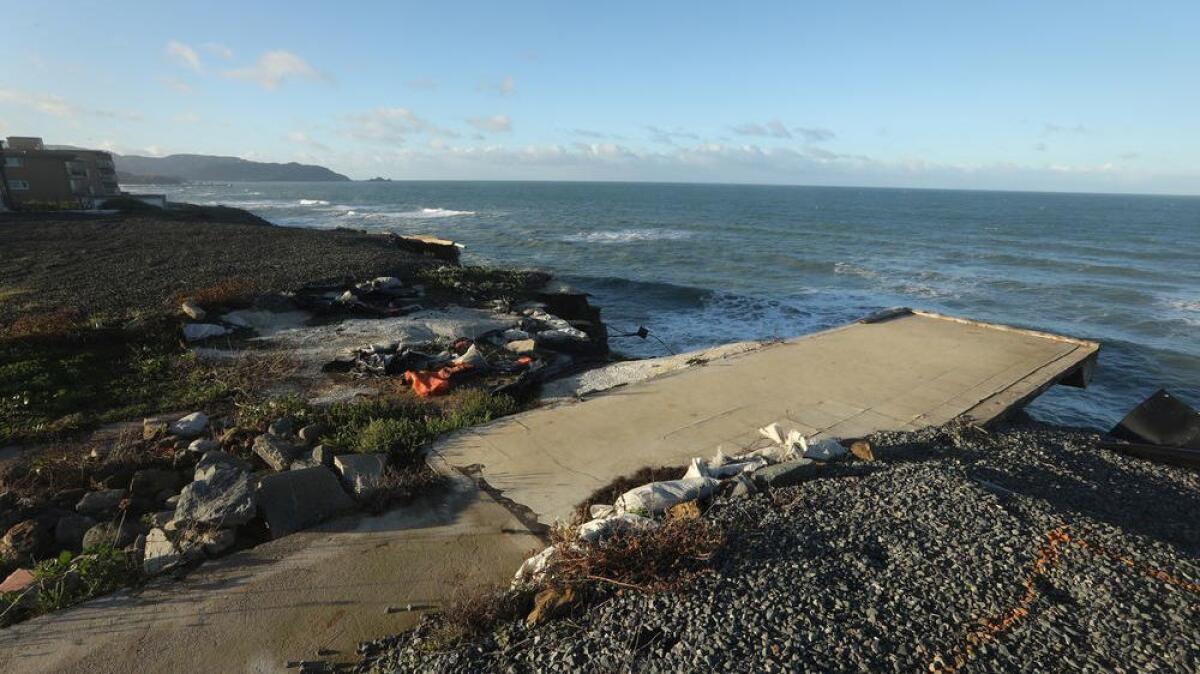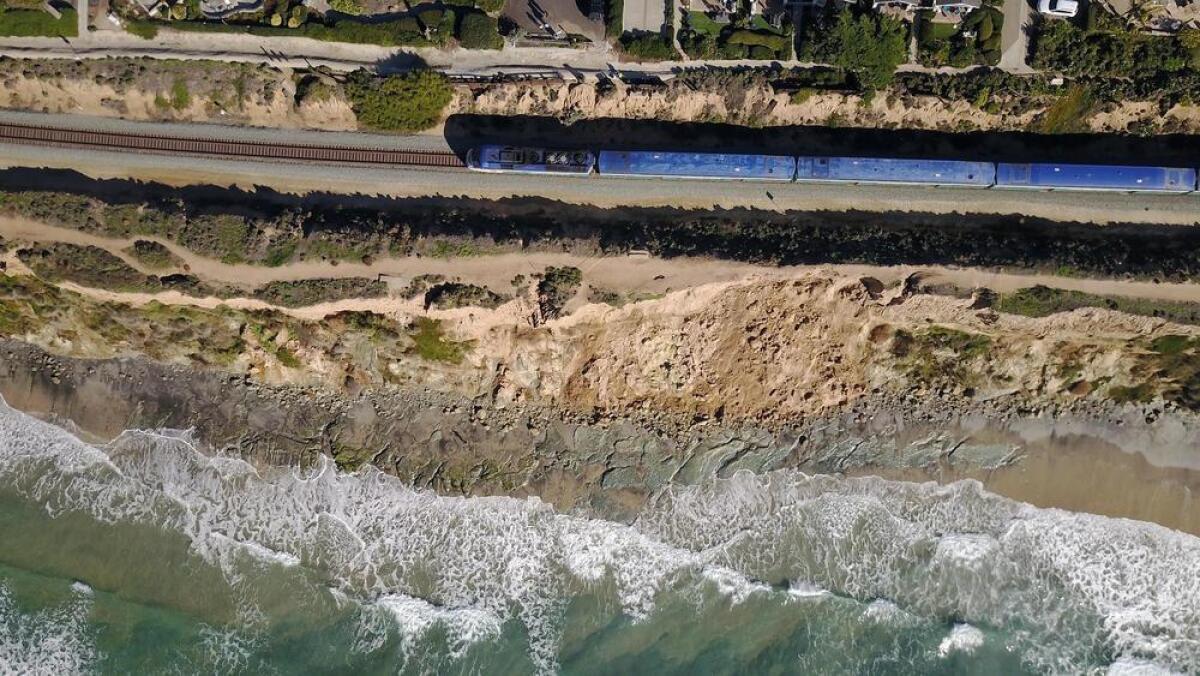Newsletter: Essential California: How to react when the sea is rising

Good morning, and welcome to the Essential California newsletter. It’s Tuesday, July 9, and I’m writing from Los Angeles.
On Sunday, we sent out a special edition newsletter highlighting a major investigation about the future of the California coast as sea levels rise. I sat down with environment reporter Rosanna Xia to dig in a little further on her story.
Rosanna told me that one thing became clear as she spent time in planning meetings, city council hearings and community workshops in cities and towns up and down the coast. The characters and details may have been different in each place, but it quickly became apparent that the same themes were playing out across California. This is a statewide story — one where there are no easy answers, but the fundamental questions are the same.
[Read “The California coast is disappearing under the rising sea. Our choices are grim” by Rosanna Xia]
Coastal communities really only have three options going forward. What are they?
If you talk to experts, coastal scientists and people who have been really looking at the evolution of the coast in California for the last couple of decades, they all will end up saying that you only have so many choices. The first is to defend the coastline, whether it’s building a sea wall or putting a bunch of large boulders to dissipate the wave energy. The idea there is to armor or harden the shoreline against the rising water and protect whatever is behind it.
Another option is to add sand. As the beaches are eroding and disappearing, the sand is washing away. So, one could say let’s just keep adding sand and try to outpace what the water is taking away by force.
The third option really boils down to relocation. Move the things that are in the way of the rising waters to somewhere further inland, and let the beach naturally migrate inland with the water.
Coastline erosion hasn’t been as prominent a topic in California as it has been in other places. Why is that?
That was a fascinating fact that kept coming up as I was doing the reporting. The scientific term for what’s been going on is “sea-level rise suppression.” But basically during the time that California was building most of its coastal development in the decades after World War II, we were in a period of a climate cycle known as the Pacific Decadal Oscillation. Which, to put it in very oversimplified terms, means that all of the warm water — which expands and has greater volume — was actually pulled further offshore because of favorable winds. The water along the West Coast was cooler, meaning it was denser, and took up less volume. It didn’t feel like the sea was rising as fast as it was to people who were building. So, they built to the edge of the water, and that edge was a lot further out than it should have been. But in the past few years or so, it’s been pretty clear that we’re now in a much warmer phase of this cycle, which means sea rise is now happening at — or above — the global average.

Will the rising sea line become as ubiquitous in the California imagination as mudslides, earthquakes and wildfires?
People call it a slow-moving disaster, I heard that a lot in my reporting. A metaphor I use in my piece is that story of a frog that was boiling to death in a pot of slowly warming water, and not realizing it. I think on the one hand, it’s a slow-moving disaster. On the other hand, the crisis is already here and it’s just a matter of noticing it.
What does it take to effectively mobilize people to take action around a so-called slow-moving disaster?
That’s the challenge. That’s why we’re doing this story before the big disaster hits. I think that as a society we’re not really good at mobilizing before a disaster, only after. Think of Katrina, think of superstorm Sandy. Think of the wildfires. What we really hope to achieve with this story is to lay out the stakes and the costs and the trade-offs ahead of time. One person I interviewed cited this report that came out that said across the nation, for every dollar that we spend ahead of time before a disaster, we save $6 in post-disaster spending.
How do you help people understand all the trade-offs at play here?
We sat down and really tried to brainstorm how to help people understand the finite amount of choices, and the costs and trade-offs inherent in every single one of these choices. And we realized why not create a game? We oversimplified the concepts, but we hope that the game helps people understand what the costs are for every decision that we make, and how each choice might create a domino effect for the coastline.
[Play “The Ocean Game” to see if you can save your town within 8 turns]
And now, here’s what’s happening across California:
TOP STORIES
Wanting to ease utility wildfire costs, Gov. Gavin Newsom faces his biggest test yet with lawmakers: There’s been no shortage of criticism for Newsom’s plan to help California’s largest utilities stave off bankruptcy from costs associated with wildfires: No focus on prevention efforts. More difficulty proving utility negligence. Too much of the financial burden falling on millions of utility customers.
The governor, six months into his first year in office, faces a crucial test this week as he attempts to convince the Legislature to ratify a multibillion-dollar utility wildfire fund before lawmakers leave Sacramento for a one-month recess. Los Angeles Times
Rep. Eric Swalwell abandoned his uphill run for president Monday, as another California Democrat, Tom Steyer, who had earlier said he would not mount a 2020 presidential run, prepared to announce that he would be entering the race. Los Angeles Times
Get the Essential California newsletter »
L.A. STORIES
Michael Mann’s novel based on “Heat,” an iconic L.A. movie that came out in 1995, will be released next year. Los Angeles Times
Lucy Jones didn’t feel the 7.1 earthquake but helped the world understand it. Los Angeles Times
After half a century, Rancho Palos Verdes bids bon voyage to the Admiral Risty restaurant. Los Angeles Times
Behold the fabled breakfast burrito trail of York Boulevard in Highland Park. L.A. Taco
Plus: L.A. Taco, a scrappy local news outlet that’s been providing exemplary alternative coverage of the city from the streets up, has hit a crossroads. It needs more paying members, or else it will cease to function as a news and feature site. L.A. Taco
Attorney Barry Kowalski, who won convictions in the Rodney King civil rights case, has died at 74. Los Angeles Times
Your support helps us deliver the news that matters most. Subscribe to the Los Angeles Times.
IMMIGRATION AND THE BORDER
How nontraditional families are separated at the border. San Diego Union-Tribune
POLITICS AND GOVERNMENT
Fresno’s mayor has vetoed funding in the city’s budget for an immigrant affairs committee and a gun violence prevention program. Fresno Bee
Modesto City Council members are questioning the $80,753 that city departments spent on food and meals in a single year. Modesto Bee
The Bay Area city of Emeryville’s minimum wage recently became the highest in the country at $16.30 per hour. But a showdown between small-business owners and unions is looming, and city voters may be forced to decide the issue. San Francisco Chronicle
CRIME AND COURTS
Kern County’s district attorney is warning residents about the possibility of illegal price gouging after last week’s earthquakes. Under state law, businesses are prohibited from raising prices more than 10% for essential goods and services for 30 days after an emergency declaration. Bakersfield Californian
The founder of the Ghost Ship artists’ collective that turned into the site of one of the deadliest blazes in California history took the stand in his manslaughter trial. Los Angeles Times
A violent brawl among family members at Disneyland was captured on video. Los Angeles Times
HEALTH AND THE ENVIRONMENT
After more than a decade, water in Lanare is finally safe to drink. The unincorporated Fresno County community had long been a poster child for California’s widespread contaminated drinking water problems. Valley Public Radio
Need to report pesticide exposure to state authorities? There’s now an app for that. Monterey County Weekly
The California Department of Forestry and Fire Protection is not enforcing wildfire-prevention rules for homeowners, leaving tens of thousands of properties vulnerable to big blazes. San Diego Union-Tribune
CALIFORNIA CULTURE
K-pop takes California: Recent data show that Los Angeles ranked as the No. 1 large market in the country for K-pop ticket sales, and Fresno took the top slot of medium-sized markets. Fresno Bee
Sacramento’s Lucia Lucas is the first openly transgender performer to play a principal role in an opera on an American stage. Sacramento Bee
The ever-present Bay Area housing crisis has contributed to increasingly strained town-gown relations in Berkeley and Palo Alto — home to top universities UC Berkeley and Stanford. San Francisco Chronicle
Employee activism is alive in tech. But it stops short of organizing unions. New York Times
A playground zipline in Davis was a huge hit — until the wife of an ex-mayor complained. Sacramento Bee
How an analog San Francisco board game store survives in a digital world. SF Gate
Burning Man can be doable for people with disabilities. Here are some tips for braving the rough desert conditions with mobility challenges. Los Angeles Times
The co-founder of MindBody, a health and fitness software company, has left his job to start a new venture selling 7-foot-tall bronze sculptures of naked women in yoga poses. Sacramento Bee
Hundreds mourned the death of 99-year-old Tuskegee Airman Robert Friend in Palm Springs. Desert Sun
CALIFORNIA ALMANAC
Los Angeles: sunny, 76. San Diego: partly sunny, 73. San Francisco: partly sunny, 68. San Jose: partly sunny, 78. Sacramento: partly sunny, 87. More weather is here.
AND FINALLY
Today’s California memory comes from Judy Samuelson:
“It was my freshman year at UCLA — Feb. 9, 1971, to be exact — when the Sylmar quake struck the San Fernando Valley. As a native of San Diego I was used to quakes, but riding this one out at Sproul Hall, an eight-story cinder block dorm constructed to roll with motion, was something entirely new. The quake registered at 6.5 and hit at precisely 6 a.m. — a little early for residents like me who ‘studied’ until 2 a.m. It threw my roommate and me out of our beds on the fourth floor overlooking the campus — and propelled us downstairs. The line for breakfast materialized within minutes, stretching all the way across the lobby.”
If you have a memory or story about the Golden State, share it with us. (Please keep your story to 100 words.)
Please let us know what we can do to make this newsletter more useful to you. Send comments, complaints, ideas and unrelated book recommendations to Julia Wick. Follow her on Twitter @Sherlyholmes.
More to Read
Sign up for Essential California
The most important California stories and recommendations in your inbox every morning.
You may occasionally receive promotional content from the Los Angeles Times.











